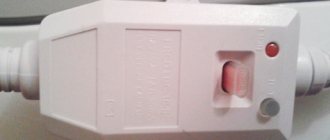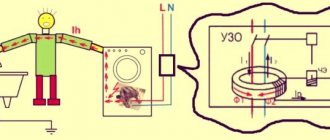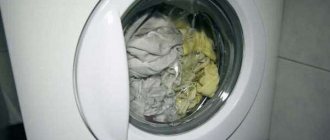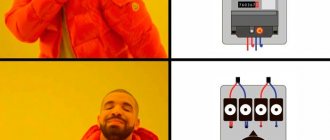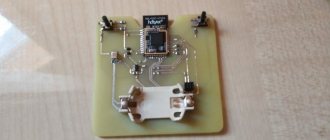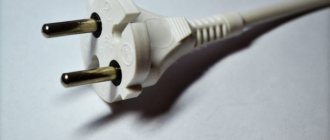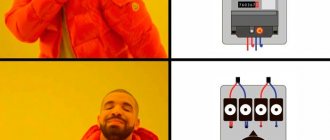Problems with the electrical network or washing machine?
In order to prevent network overloads or a malfunction in the machine from completely destroying the equipment, it is necessary to establish why the meter is knocked out and eliminate the cause of the malfunction.
When the washing machine is under warranty or a complex electrical unit needs to be replaced, diagnostics and repair work must be carried out by specialists.
But perhaps the problem is in the power supply or in the contacts? Before you call a technician to your home, you need to find out why the meter goes off when you turn on the washing machine.
First you need to disconnect the device itself and household electrical appliances from the network and inspect the power circuits outside the washing machine.
See also -
Why does the washing machine jump or vibrate when spinning?
What is a difavtomat?
This is a device similar in purpose to an RCD, but with expanded functionality. Because it contains a built-in circuit breaker, the operation of which is the same as that available in the distribution panel common to the house. In addition to triggering a circuit interruption when a leak is detected, the differential circuit breaker protects home appliances connected to the network from overloads that occur in it and the consequences of short circuits on the line.
Expert opinion
I work in the household appliance repair industry. Extensive experience in restoring washing machines and dishwashers.
Ask a Question
That is, its presence guarantees reliable protection against a greater number of problems due to violation of the integrity of the wiring, incorrect use of a switched-on electrical appliance, or changes in voltage for any reason.
Plugs knock out when the washing machine is turned on: we are looking for the reason in the wiring
Due to the power supply system, the RCD circuit breaker trips in the following cases:
- When the RCD is of low quality, low capacity or incorrectly adjusted. This is the most common option and is possible when you turn on any function of the washing machine, even when draining the water. To forget about the problem, it is enough to adjust or replace the machine itself. (See also: How to choose an automatic circuit breaker (RCD) for a washing machine?)
- Increased load on the meter. When you turn on the machine, you must turn off other powerful electrical appliances, such as a microwave or electric stove.
- Damage to electrical wiring or socket. To check them, you need to connect an electrical appliance of the same power. When the RCD breaks out again, it means the reason is in the wiring.
The adjustment or replacement of the RCD must be carried out by specialists. Otherwise, unauthorized intervention in the machine, meter or traffic jams is fraught with overheating of the electrical network and ignition.
External reasons
Wires are damaged
- A current leak in a household network in an apartment or private house may be due to the fact that the electrical wiring is old and can no longer withstand the maximum permissible loads (the “machine” knocks out).
- The insulation of the old wiring may have dried out, leaving the wire exposed in some areas. Also, the cross-section of aluminum wires could be reduced in some places (often in contact areas and electrical boxes) due to kinks.
- Another possible reason is a recent replacement of electrical wiring (if any), poor connection of wires due to improper installation.
- There may be a simple damage to the wire in the wall: maybe you drove a nail into the wall to hang a picture and accidentally broke the insulation of the electrical wiring hidden in the wall.
- The circuit often includes not only a washing machine, but also other household appliances: a microwave, kettle, air conditioner, heater and other powerful electrical appliances operate simultaneously. Find out what other devices are connected to this circuit and make sure that the reason for turning off the machine is not their fault. To do this, check the correct operation of all electrical appliances connected to the circuit.
RCD tripped
Check if the RCD (residual current device) has tripped. The device ensures that the current of equal strength flows through the “phase” and “zero” wires, and turns off the voltage supply if the currents are unequal. Often the RCD and the current circuit breaker are combined in one device - a difavtomat, installed in the panel (often near the meter).
The most likely cause of device failure is incorrect connection of the machine. Check whether it is correctly connected to ground, whether the cable is intact and whether the body of the machine is touching a metal bath or pipes.
There is also an RCD on the water heater. It can work for a number of reasons: the insulation of the heating element or the cables to which it is connected is broken. The metal parts of the device touch exposed wires, the boiler is leaking, the humidity in the room is too high, due to which condensation accumulates, or overheating due to the fact that the RCD does not match the power of the heating element.
The machine is installed with the wrong value or quality
The RCD may be of poor quality, low capacity, or simply incorrectly adjusted. In this case, the machine will turn off (cut out) when you turn on any function of the machine, for example, when spinning or draining water. If the problem lies in the machine, it just needs to be replaced or adjusted, if possible.
The device is selected according to the rated current in the circuit in which it will operate. The power of a washing machine often does not exceed 3 kW, so a protective device with a rated current of 16 amperes will be sufficient. If we choose a protective circuit breaker, its task is to prevent damage to the wiring due to overloads or short circuits. For example, in the event of a breakdown of the heating element's spiral.
The power line of the washing machine is laid with a single-core copper cable with a core cross-section of at least 2.5 mm²; for such conductors the maximum current is 25A. It is advisable that the power supply circuit of the washing machine be protected by a two-pole circuit breaker, which prevents polarity reversal in the alternating current network. It is optimal to choose the shutdown characteristic “B”, as it is the most sensitive for household networks.
It is best to set the rated leakage current to 30 mA. At a higher value, the machine may not operate even with a fairly sensitive breakdown of the insulation on the housing. But too high a sensitivity threshold (for example, 10 mA) can lead to false alarms due to other leaks in a rather complex power supply circuit for household appliances.
The RCD itself, if you still need to replace it, it is better to choose a mechanical one, because it will be more reliable. It would be best to entrust the replacement work to a specialist, since for this procedure it will be necessary to de-energize some part of the house.
Knocking out plugs: the cause of problems in the washing machine
So, the above options have been tested and not confirmed, therefore, the reason is in the device itself.
Before diagnostics or inspection, the device must be de-energized and make sure that there is no water left in the washer. Otherwise, there is a high probability of electrical and even mechanical injuries, since the washing machine contains rotating components and assemblies.
There are several reasons why traffic jams, an RCD or a meter knock out:
- due to damage to the plug or power cord;
- as a result of short circuit of the heating element;
- as a result of a malfunction of the network filter;
- due to a faulty engine;
- due to a faulty interference filter;
- as a result of a malfunction of the control button;
- due to damaged and frayed electrical wires.
Correctly connecting the SMA
The washing machine is in contact with electricity and water at the same time, and therefore is a potentially dangerous device. Correct connection ensures the safety of people and the equipment itself.
Wires
The machine must be connected to a grounded outlet to prevent electrical injury. It is advisable to use a separate wiring line coming directly from the distribution board. This is necessary in order not to overload other wiring, since the washing machine uses a powerful heating element during operation.
The wires must have three copper cores with a cross-section of at least 2.5 mm², with a separately installed automatic circuit breaker and RCD.
RCD
Washing machines have different powers up to 2.2 kW and higher; they must be connected through an RCD to protect people from electric shock.
The device must be selected taking into account the power consumption. The element can be designed for 16, 25 or 32 Amperes, the leakage current is 10-30 mA.
RCD
Machine
Also, equipment can be connected through a circuit breaker with differential protection. Its selection proceeds in the same way as the RCD. The marking of a device for a household network must have the letter “C”.
The appropriate class is indicated by the letter "A". There are machines with class “AC”, but they are less suitable for working with heavy loads.
Automatic machine for home
Damage to the power cord or plug
Diagnostics always starts with the electrical wire and plug. During operation, the cord is subject to mechanical stress: it is pulled, overlapped, pinched. As a result of damage, the plug and electrical outlet do not make good contact.
Check the wire for damage with a multimeter. Replacing the power cord is as follows:
- it is necessary to turn off the power to the washing machine and close the inlet valve;
- use a hose to drain the water (turning the washing machine over is strictly prohibited);
- Unscrew the screws located around the perimeter and remove the panel;
- remove the surge protector from the housing by unscrewing the screw;
- press the latches, remove the plastic stopper by squeezing it out;
- move the electrical wire inward and to the side, thereby gaining access to the filter and disconnecting it;
- carefully pull out the power cord from the machine;
To install a new cord, you need to perform these steps in reverse order.
Electronics or power wiring
If everything is in order with the surge protector and the buttons on the dashboard, then you should “ring” the remaining wire connections of the washer. Since the control unit is already being studied, it is worth continuing the inspection from there. We act sequentially: apply multimeter probes to each terminal. First of all, we pay attention to suspicious elements, frayed, burnt or loose.
For a comprehensive diagnosis of the control board, special equipment is required, so it is better to turn to professionals.
When diagnosing the control board, it is better to do only a visual inspection. Any careless action can lead to irreparable consequences, including the “fatal outcome” of the equipment. Comprehensive testing of the module should only be carried out by professionals using special equipment.
The reason for the traffic jams may not be in the board. Therefore, we take a tester and use it to call the wiring connected to the electric motor, pump, heating element, pressure switch and other sensors and devices. All burnt elements encountered must be replaced, even if their performance is confirmed by a multimeter.
Short circuit of the heating element
Due to poor-quality water and chemicals, the heating element is “eaten up”, various impurities and scale accumulate. Heat transfer deteriorates, the heating element overheats and a short circuit occurs. As a result, the meter and traffic jams are knocked out.
To check the heater, disconnect the power cord and measure the resistance using a multimeter, setting the limit to ohm. Normally, the resistance should vary from 20 to 50 ohms.
Sometimes the heating element “shorts” to the body. To exclude this cause, the outputs and grounding bolts are measured for resistance one by one. Even a small reading on the multimeter indicates a short circuit, and this is the reason the RCD turns off.
To replace the heating element you need:
- Remove the back panel if the device is located at the rear. If the heating element is in front, first remove the control panel, then the front cover;
- Unscrew the nut of the grounding bolt approximately 6 turns, push the bolt inside;
- use a screwdriver to pry up the heating element and carefully remove it;
When replacing the heating element, do not tighten the nut tightly, since you can squeeze the heating element out of the tank.
Let's check the electrical network
When turned on and running, the machine puts a significant load on the electrical network. Manufacturers of household appliances, including Bosch, warn about the “electrical gravity” of washing machines and prescribe certain requirements for its operation. Among them, there is the need to allocate a separate branch for SMA, protected by RCDs and automatic devices. The type of wires is also recommended: VVG cable with a cross-section of 3x2.5. It doesn’t matter what washing model you buy, compact, full-size, equipped with a dryer or not.
In reality, users do not follow safety precautions. More often, the washing machine is connected to a common outlet with other household appliances, through an extension cord or “tee”. All this leads to overheating and damage to the wires, after which the socket melts, the RCD is triggered and the light turns off. It’s easy to suspect something is wrong: the insulation on the conductors is dark, the plastic is melted, and you can hear a burning smell.
You can avoid network congestion and subsequent problems if:
- allocate a separate branch for the washing machine;
- evaluate the quality of the installed wiring;
- insert a moisture-resistant socket (has a special lid);
- include an RCD in the circuit.
It is strongly not recommended to connect the washing machine to the network through an extension cord or adapter - it is dangerous!
If there are no visible signs of overheating and damage to the wires and socket, then you need to check the power cord from the inside. We unscrew the bolts holding the back panel, remove it, and then take out the cable itself. Then, using a multimeter, we “ring” the wires for breakdown. We immediately assess the condition of the terminals and contacts. Defective parts must be replaced.
Engine malfunction
The cause of a short circuit in the engine wiring occurs when the device is used for a long time or the integrity of the tank or hose is damaged. The motor contacts and the surface of the washing machine ring in turn; if a malfunction is detected, the motor is replaced and, if possible, repaired. The leak must be repaired.
In addition, the plugs or the RCD are knocked out as a result of wear on the motor brushes. In this case, they are dismantled by removing the contacts from the terminals. After installing the new brushes, manually turn the motor pulley. And if they are installed correctly, the electric motor should not make loud noise.
Car breakdowns
The reasons can be not only external, but also inside household appliances. Often the answer to the question of why traffic jams are knocked out in an apartment is a banal malfunction of the socket, car plug or cord. If the socket is not in order, you can simply figure out the malfunction: try plugging in another device - the power should be 2000-2500 W. If in this case it knocks out, repairs are required, it is quite possible that the contacts have simply become loose. To check the cord, a specialist will ring all three wires that are present in the network cable. Usually the cable deteriorates from twisting, kinks and other mechanical damage.
Other violations are usually associated with malfunctions in the equipment itself. And if all external troubles are excluded, under no circumstances should you restart the car; on the contrary, you should turn it off and invite a technician to repair it.
Broken and frayed electrical wires
As a rule, frayed electrical wires occur in a hard-to-reach area of the washing machine. When the device vibrates when draining water or drying, the electrical wires rub against the panel and after some time the insulation will fray. An electrical short on the body is the result of the machine being triggered. Locations of wire damage are determined visually: carbon deposits and darkened areas of melting appear on the insulating layer. These areas require soldering and re-insulation.
In conclusion, I would like to warn you: if the machine knocks when you turn on the washing machine, there is a high probability of electric shock. It is very dangerous! In addition, even minor disturbances in the electrical wiring of the device or in the electrical network lead to ignition.
Therefore, it is not recommended to turn on the RCD machine and continue washing, but it is necessary to identify and eliminate the cause of the malfunction.
See also:
- 15 best washing machines
- 15 best washing machines from 30,000 to 40,000 rubles according to customer reviews
- 5 Best Whirlpool Washing Machines Based on Customer Reviews
- 6 best Bosch washing machines according to customer reviews
- 7 best Indesit washing machines according to customer reviews
Tips and videos
The ban on using extension cords in the bathroom is worth heeding. Because the more points of obstacles in the line, the higher the losses leading to overheating in these places. And in conditions of high humidity this is especially dangerous and can lead to a short circuit while the washing machine is operating. Which sooner or later will happen due to accelerated wear of the contact group in the plug and socket of the extension cord.
The process of purchasing and installing an RCD by someone called in, rather than by a home repairman, does not hit your pocket as hard as a washing machine breaking down due to a power surge. Therefore, if the farm lacks such an element of protection, it is advisable to correct the situation as soon as possible. So that you don’t have to regret your sluggishness, power outages and subsequent problems because of this are becoming more and more pressing every year.
Short circuit of the network wire
If the socket is working properly, the reason may be a short circuit in the power cord. A short circuit occurs when a wire carrying voltage touches another live wire or neutral wire. Preventing this emergency situation is possible if tension or overlap of wires is detected and eliminated in time.
To diagnose a short circuit you need:
- closing the valve supplying water to the machine;
- draining water from it;
- removing the bottom;
- For diagnostics, connect the wire to the FPS and to the output on the housing.
Machine breakdowns leading to tripping of the circuit breaker
If it suddenly “shorts out,” then sometimes the cause may be simple moisture that collects on the internal elements of household appliances. If it “shorts” precisely because of condensation, then you can try to dry the car by leaving it to ventilate for 2-3 days in a dry room. However, humidity rarely causes the operation, and more often washing machines suffer from the following ailments:
- “shorts out” due to a malfunction of the heating elements - this element is especially vulnerable because it is in contact with water and microelements that corrode the surface of the heating coil, which leads to a violation of the integrity of the tubular electric heater and a short circuit. In this case, a specialist will replace the heating element, and the problem will be resolved;
- the motor is broken - this usually happens in old cars, which have natural wear and tear on the motor. Sometimes this situation is caused by an internal water leak. Both failures lead to a short circuit. In this case, the faulty motor is not repaired, but replaced with a new one;
- the control panel has burned out or failed - the short circuit occurs due to oxidation of the contacts on the board, which requires either repair or replacement;
- The power button is broken - a fairly common case, because we use the button more often than others, which is why its contacts quickly fail.
